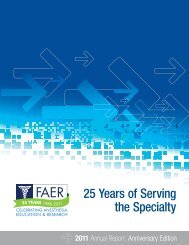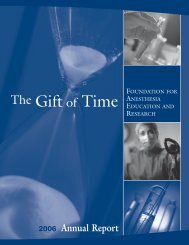2010 MSARF Symposium Participants - Foundation for Anesthesia ...
2010 MSARF Symposium Participants - Foundation for Anesthesia ...
2010 MSARF Symposium Participants - Foundation for Anesthesia ...
You also want an ePaper? Increase the reach of your titles
YUMPU automatically turns print PDFs into web optimized ePapers that Google loves.
dehydration of the intravascular space. Recognizing how the presence of glycosuria affects urine volume and composition<br />
in surgical patients is important <strong>for</strong> preemptively managing fluids and insulin <strong>for</strong> the best clinical outcomes.<br />
Student Name: Albert Tsai<br />
Host Department: University of Pennsylvania School of Medicine<br />
Primary Mentor Name: Max Kelz, MD, PhD<br />
Title of Research Project: Disruption of Circadian Rhythms Following Extended Exposure to Isoflurane in<br />
Drosophila<br />
Background: Circadian rhythms are fundamental to all eukaryotes and can be characterized by a neuronal circuit<br />
consisting of input, core clock, and output components. Given that anesthetics disrupt synaptic signaling, it is not<br />
surprising recent studies suggest anesthetics might affect circadian rhythms. However, the mechanisms through which this<br />
occur remain unknown. Using Drospohila we investigate the effects of volatile anesthetics upon circadian functioning.<br />
Methods: Flies were entrained on a 12-h light/12-h dark schedule and subsequently placed into constant darkness. 1.2%<br />
isoflurane was delivered <strong>for</strong> 2 or 6 hours at different circadian times to determine anesthetic effects on a circadian<br />
output—locomotor behavior. Separately, light pulses were given during 2-hour isoflurane exposures to determine if the<br />
clock remained responsive to inputs. Finally, isoflurane and halothane were applied directly to cultured cell reporter<br />
system to determine the effects upon the core clock.<br />
Results: During a 2-hour 1.2% isoflurane anesthetic, input, output, and core circadian clock functions remained<br />
unaffected. Core clock function was also unaffected by 1.0% halothane. However, output of the clock was significantly<br />
shifted by a 6-hour 1.2% isoflurane exposure, yielding phase shifts ranging from -43 minutes to +75 minutes, with no<br />
effect on the circadian period.<br />
Conclusions: These results suggest normal circadian functioning following acute exposures to volatile anesthetics.<br />
However, following prolonged exposure to isoflurane, circadian disturbances arise, which may be attributable to<br />
accumulation of homeostatic drive and its interaction with the circadian process. Clinically, this might suggest a dosedependent<br />
effect of general anesthetics on circadian rhythm disruptions following surgery.<br />
Student Name: Ajayram Ullal<br />
Host Department: Montefiore Medical Center The University Hospital <strong>for</strong> the Albert Einstein College of Medicine<br />
Primary Mentor Name: Linda Shore-Lesserson, MD<br />
Additional Mentors: Elise Delphin, MD<br />
Title of Research Project: A randomized, double-blinded trial comparing the efficacy of tranexamic acid and<br />
epsilon-aminocaproic acid in reducing bleeding and transfusion in cardiac surgery.<br />
Background: Patients who undergo cardiopulmonary bypass (CPB) <strong>for</strong> cardiac surgery are at high risk <strong>for</strong> post-operative<br />
bleeding. Without aprotinin available, two lysine-analogues, tranexamic Acid (TA) and epsilon-aminocaproic acid<br />
(EACA) have become the standard of care to control bleeding following CPB. The purpose of this study is to compare<br />
TA to EACA in reducing bleeding and transfusion requirements following CPB.<br />
Methods: This is a single-center, randomized, double-blind trial targeted to enroll 196 adult patients undergoing cardiac<br />
surgery involving CPB. Patients randomly receive prophylactic EACA or TA at standard dose. Blood is sampled at<br />
baseline, after loading dose, and post-protamine <strong>for</strong> ROTEM®, Thromboelastography (TEG), and D-Dimer analyses.<br />
Chest tube drainage(CTD) and transfusions are followed <strong>for</strong> 24 hours, and complications assessed up to 30 days.<br />
Results: Blinded interim analysis after 81 patients reveals no statistically significant differences between groups in CTD,<br />
transfusion volumes, TEG/ROTEM parameters, or complications. One group, did have a non-statistically significant<br />
trend towards a lower transfusion rate (p





